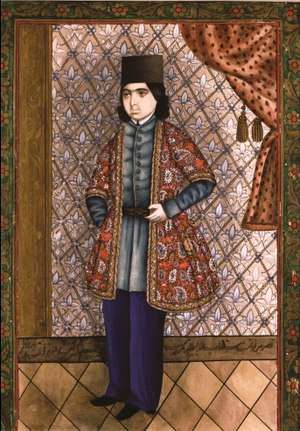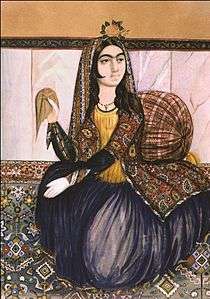Mirza Kadym Irevani
| میرزا قدیم ایروانی | |
|---|---|
| Born |
1825 Erivan, Erivan Khanate, Qajar Iran |
| Died |
1875 Erivan, Erivan Governorate, Russian Empire |
| Known for | Panel painting |

Mirza Kadym Irevani[lower-alpha 1] (Azerbaijani: میرزا قدیم ایروانی) was an Azerbaijani ornamentalist artist and portraitist,[1] who mostly created "typical Persian miniatures and lacquers".[2]
Mirza Kadym Irevani is famous for his drawings and miniature paintings.[1] In the 1850s, he was commissioned by the Russians to repaint the interior of the Erivan Sardar's Palace, which had originally been painted by a Persian artist in 1815.[3] Mirza Kadym Erivani's works are kept in the National Art Museum of Azerbaijan, the Art Museum of Georgia, and the Hermitage.
Biography
Mirza Kadym Irevani was born in 1825, in the city of Erivan in Qajar Iran during the tenure of the last Iranian governor of the Erivan Khanate, Hossein Khan Sardar, and belonged to a "family of professional decorators".[1][4] During Hossein Khan's capable governorship, Erivan prospered; the Sardar's Palace became decorated with mirrors, stuccos, and fourteen paintings.[1][5]
The paintings depicted four heroes from the Iranian Shahnameh epic, including Rostam and Sohrab, as well as contemporary Iranian notables; king Fath-Ali Shah Qajar (r. 1797–1834), Abbas Mirza, Hossein Khan Sardar, and his brother Hasan Khan Qajar.[6] Other paintings included two hunting and battle scenes.[6] All fourteen paintings were originally painted in 1815 by a Persian painter named ʿAbd al-Rāziq.[6]
During the decisive siege of Erivan in 1827 by the Russians, during the Russo–Persian War of 1826-1828, the Russian artillery gravely damaged the Sardar's Palace.[6] After the Iranians were forced to cede Erivan to the Russians per the Treaty of Turkmenchay of 1828, the Erivan Sardar's palace was neglected by the Russians, and thus fell in ruins.[6] A few decades later, in 1850, when Orientalism came in vogue, the Russians decided to rebuild the palace.[7] The Russians commissioned Mirza Kadym Irevani to repaint the interior of the palace.[8] Thus; "all historical figures depicted on the walls of the palace were from 30-40 years earlier than the time of Mirza Kadym Irevani".[9]
Mirza Kadym Irevani's oeuvre consists mostly of "typical Persian miniatures and lacquers".[1] He also created some "monumental and easel paintings with figurative motives", but they are considered to be of lesser aesthetic quality.[1] In relation to his oeuvre, Associate Professor Irina Koshoridze adds:[1]
The color range is not quite rich, and the proportions of the figures are not always right; they are occasionally even primitive. In the murals of the palace, he tried to follow the old schemes of the paintings of ʿAbd al-Rāziq, which is why the costumes and the compositional setting of the paintings have similarities with earlier Persian paintings (e.g., the Zand turbans, the early Qajar style cloth).
Mirza Kadym Irevani's paintings of the Sardar's Palace, as well as "a few of his oil paintings" are kept in the National Art Museum of Azerbaijan.[1] Some of his other works are kept in the Hermitage in St. Petersburg.[1] Five paintings (Rostam, Sohrab, Fath-Ali Shah Qajar, Hossein Khan Sardar, and Hasan Khan Qajar) were moved to Georgia after the Russians demolished the Palace in 1914, and are kept in the Oriental arts department of the Art Museum of Georgia.[6]
Gallery
 Portraits in the Sardar's Palace in Erivan (Yerevan)
Portraits in the Sardar's Palace in Erivan (Yerevan) "Portrait of sitting woman", Tempera, 1870's, National Art Museum of Azerbaijan
"Portrait of sitting woman", Tempera, 1870's, National Art Museum of Azerbaijan
Notes
References
- 1 2 3 4 5 6 7 8 9 10 Koshoridze 2008, p. 246.
- ↑ Koshoridze, Irina (2008). Arjomand, Saïd Amir, ed. "Two 18th-Century Royal Palaces in Georgia and Armenia". Journal of Persianate Studies. BRILL. 1 (2): 246. doi:10.1163/187471608786303920.
His works are mostly typical Persian miniatures and lacquers; he was also interested in monumental and easel paintings with figurative motives, where his skills left a little to be desired.
- ↑ Koshoridze, Irina (2008). Arjomand, Saïd Amir, ed. "Two 18th-Century Royal Palaces in Georgia and Armenia". Journal of Persianate Studies. BRILL. 1 (2): 245. doi:10.1163/187471608786303920.
The paintings depicted Fath-ʿAli Shah, ʿAbbās Mirzā, Hosayn Khan and his brother Hasan Khan Qajar, two hunting and battle scenes and four paintings of Shāh-nāma heroes, Rostam and Sohrāb, and two others. The Persian painter ʿAbd al-Rāziq had executed all these paintings in 1815.
- ↑ Hambly 1991, p. 552.
- ↑ Kettenhofen, Bournoutian & Hewsen 1998, pp. 542-551.
- 1 2 3 4 5 6 Koshoridze 2008, p. 245.
- ↑ Koshoridze 2008, pp. 245-247.
- ↑ Koshoridze 2008, pp. 244-245.
- ↑ Koshoridze 2008, p. 247.
Sources
- Hambly, Gavin (1991). "The traditional Iranian city in the Qājār period". In Avery, Peter; Hambly, Gavin; Melville, Charles. The Cambridge History of Iran (Vol. 7). Cambridge University Press. p. 552. ISBN 978-0521200950.
- Kettenhofen, Erich; Bournoutian, George A.; Hewsen, Robert H. (1998). "EREVAN". Encyclopaedia Iranica, Vol. VIII, Fasc. 5. pp. 542–551.
- Koshoridze, Irina (2008). Arjomand, Saïd Amir, ed. "Two 18th-Century Royal Palaces in Georgia and Armenia". Journal of Persianate Studies. BRILL. 1 (2). doi:10.1163/187471608786303920.